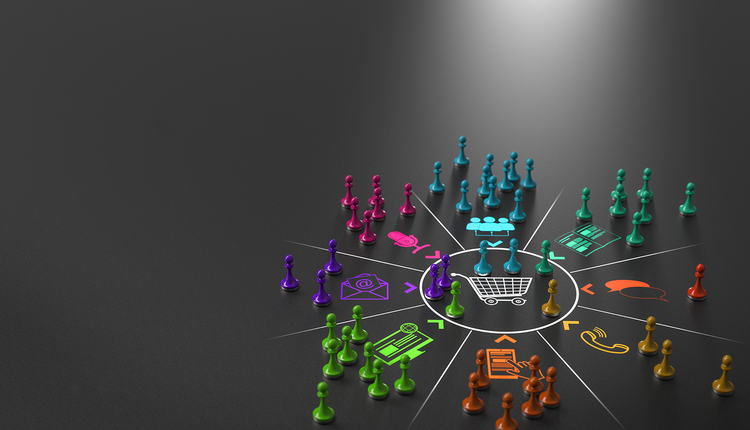Ah, the Mail Moment! You come home from work, feed the cats, feed the dog (at least that how it works in my house), and get the day’s mail out of the mailbox. Flipping through it, you see a postcard for window replacements and stop to look at it for a second. “Hmm,” you think, “we need to get new windows. I wonder if these guys are any good...” There’s a free window offer on it, so you set it aside on the kitchen counter. Eventually you pile a couple of credit card offers and a magazine on top of it, and start making dinner.
After dinner, you sit at your computer to check the news, see if you got any emails, and just relax. On the news web site you see a banner ad for that same window company. “Oh yeah. I need to remember to call them tomorrow.” You check your email, and there is an email from that same window company with the same offer – in fact, it looks a lot like the mail piece that your wife just put on the recycling pile. “Oh good,” you think. “I’ll just click on this and request some information.”
Mission accomplished, coordinated direct marketing! We just delivered a prospect!!
Now, if you had only gotten the mail piece, you may have well forgotten all about it by the next day – that is often the fate of direct mail. After all, your wife had already gotten rid of the piece. The banner ad by itself barely registered – it caught your attention because you had gotten a piece of mail. You wouldn’t normally even open an email from that window company, but your interest had been piqued by the other channels, and the email gave you an easy way to respond, right then. The combined effects of a multi-channel campaign worked on you.
And this is not just anecdotal – study after study show that response rates are better when multiple marketing channels are used together. There are a lot of terms for this kind of marketing – integrated, multi-channel, omni-channel, and more. Let’s call it coordinated direct marketing for our purposes. The key is to take multiple channels and have them work in concert.
Direct Mail – Still the Indispensable Channel
For much of direct marketing, mail remains an irreplaceable channel. There are certain qualities to direct mail that other channels just can’t deliver:
Targetability. Direct mail can be easily and effectively targeted — it is really the only channel where you can simply buy — or at least rent — a list of your best prospects. Want to send a message to all of the plumbers in Baltimore? Direct mail can do that. Other channels just don’t offer that precision. You can buy email lists, but they are much less reliable and complete.
Market Penetration. With direct mail, you have a good chance that your message will be seen, and maybe even read! The latest USPS household study showed that more than 80% of mail pieces were at least looked at — maybe on the way to the dustbin, but that’s OK — you still made an impression. If it’s the right offer at the right time you’ve got a solid shot at response. On a marketing email, you’re lucky if you get a 10% open rate — 90% of your prospects will never see your offer. Direct mail gets more eyes.
Exclusivity. How many emails did you get today? How many banner ads did you see? 100? 500? Now how many pieces were in your mailbox at your home? Six or seven? Your mail piece has a lot less competition in the mailbox.
The Mail Moment. The Postal Service talks about this a lot, because it’s a real thing – the Mail Moment. There is a time when most people in America stop and got through their mail. For that 30 seconds, or however long it takes, you have their undivided attention. This is a great moment for your offer. No other channels harness attention in the same manner.
But It’s Not Perfect…
For all of its strengths, direct mail faces some real challenges, too. These weaknesses are what we are trying to overcome in a multichannel campaign.
It’s expensive. Direct mail is an investment. When you factor in design, production, and postage, a typical direct mailing costs fifty cents to a dollar or more per piece. So where I might casually fire off an email to a few thousand of my closest friends, I’m going to think a little mare about the message I’m including in my mail piece.
It requires effort to respond. Even when you get the perfect offer into just the right person’s hands, they still need to take action to respond. They need to call someone, go to a website, mail in a postage-paid card. This all requires effort, and too many times that piece of mail is set on a kitchen counter or buried in a pile on a desk because even though there was interest in the offer they couldn’t respond at that moment. There’s still no button we can put on a mail piece to let them respond – they have to do something.
Unpredictable delivery time. You never know exactly when your mail is going to be delivered — you don’t even know what day, maybe not even what week. Standard mail traveling across the country can be delivered in a couple of days… or a couple of weeks. It’s tricky to coordinate other marketing with it in a meaningful way.
Tying other channels to support your direct mail can help you leverage direct mail’s best qualities and mitigate its weaknesses. If you are a direct mail marketer, your direct mail will virtually always get better response rates if you can coordinate it with other channels.
Email coordinated with your direct mail can overcome the effort to respond to direct mail. If you can time an email to arrive on the same day the direct mail piece arrives, you give your prospect another opportunity to respond — right then and there with a click. If you have already captured their interest with the mail piece, you can capture their business with the same message reinforced in an email. Of course this works best with customer or house lists where you already have a good percentage of emails. For those efforts where emails are available, our experience is that the email will boost response every time.
Coordinating other channels, in general, will boost response for a direct mail effort. While coordinated marketing can’t exactly make direct mail less expensive, it can increase its chances for success. If you are making the considerable investment required to send direct mail, other channels can support it and improve response rates. Ads can be run on social media sites, like Facebook, coordinated to begin showing up as your mail is delivered, reinforcing your brand and the offer. IP targeting allows you to push web display ads to the IP addresses of many of your prospects, again to reinforce your brand and offer. Even without email addresses you can use many of these other marketing channels to better immerse your prospects in your brand and boost response.
A winning multi-channel campaign has direct mail at its core and a coordinated plan at the start. The essential elements of any successful marketing campaign are the same, but they become more apparent when you start trying to make channels work together. The essential elements of a campaign are:
· The offer
· The call to action
· The landing page
· The tools to coordinate it all.
Next time we’ll walk through creating your multi-channel campaign – step by step.
Dave Lewis, President, SnailWorks, LLC can be reached at dlewis@snailworks.com.















